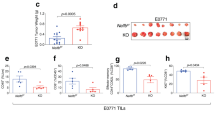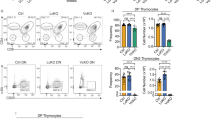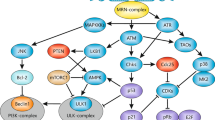Abstract
LYMPHOCYTES are particularly susceptible to DNA damage-induced apoptosis, a response which may serve as a form of 'altruistic suicide' to counter their intrinsic high potential for mutation and clonal expansion1. The tumour suppressor p53 has been shown to regulate this type of apoptosis in thymocytes2,3, but an as yet unknown, p53-independent pathway(s) appears to mediate the same event in mitogen-activated mature T lymphocytes4. Here we show that DNA damage-induced apoptosis in these T lymphocytes is dependent on the antioncogenic transcription factor interferon regulatory factor (IRF)-l (refs 5-7). Thus two different anti-onco-genic transcription factors, p53 and IRF-1, are required for distinct apoptotic pathways in T lymphocytes. We also show that mitogen induction of the interleukin-lβ converting enzyme (ICE) gene8á¤-10, a mammalian homologue of the Caenorhabditis elegans cell death gene ced-3, is IRF-1-dependent. Ectopic overexpression of IRF-1 results in the activation of the endogenous gene for ICE and enhances the sensitivity of cells to radiation-induced apoptosis.
This is a preview of subscription content, access via your institution
Access options
Subscribe to this journal
Receive 51 print issues and online access
$199.00 per year
only $3.90 per issue
Buy this article
- Purchase on Springer Link
- Instant access to full article PDF
Prices may be subject to local taxes which are calculated during checkout
Similar content being viewed by others
References
Cohen, J. J., Duke, R. C., Fadok, V. A. & Sellins, K. S. A. Rev. Immun. 10, 267–293 (1992).
Lowe, S. W., Schmitt, E. M., Smith, S. W., Osborne, B. A. & Jacks, T. Nature 362, 847–849 (1993).
Clarke, A. R. et al. Nature 362, 849–852 (1993).
Strasser, A., Harris, A. W., Jacks, T. & Cory, S. Cell 79, 329–339 (1994).
Miyamoto, M. et al. Cell 54, 903–913 (1988).
Harada, H. et al. Science 259, 971–974 (1993).
Tanaka, N. et al. Cell 77, 829–839 (1994).
Cerretti, D. P. et al. Science 256, 97–100 (1992).
Thornberry, N. A. et al. Nature 356, 768–774 (1992).
Yuan, J., Shaham, S., Ledoux, S., Ellis, H. M. & Horvitz, H. R. Cell 75, 641–652 (1993).
Harada, H. et al. Cell 63, 303–312 (1990).
Tanaka, N., Kawakami, T. & Taniguchi, T. Molec. cell. Biol. 13, 4531–4538 (1993).
Willman, C. L. et al. Science 259, 968–971 (1993).
Harada, H. et al. Oncogene 9, 3313–3320 (1994).
Miura, M., Zhu, H., Rotello, R., Hartwieg, E. A. & Yuan, J. Cell 75, 653–660 (1993).
Wang, L., Miura, M., Bergeron, L., Zhu, H. & Yuan, J. Cell 78, 739–750 (1994).
Reed, J. C. J. Cell Biol. 124, 1–6 (1994).
Oltvai, Z. N., Milliman, C. & Korsmeyer, S. J. Cell 74, 609–619 (1993).
Yin, X.-M., Oltvai, Z. N. & Korsmeyer, S. J. Nature 369, 321–333 (1994).
Kumar, V. et al. EMBO J. 5, 2231–2236 (1986).
Eilers, M., Picard, D., Yamamoto, K. R. & Bishop, J. M. Nature 340, 66–68 (1989).
Kirchhoff, S., Schaper, F. & Hauser, H. Nucleic Acids Res. 21, 2881–2889 (1993).
Shibuya, H., Yoneyama, M., Ninomiya-Tsuji, J., Matsumoto, K. & Taniguchi, T. Cell 70, 57–67 (1992).
Casano, F. J., Rolando, A. M., Mudgett, J. S. & Molineaux, S. M. Genomics 20, 474–481 (1994).
Cerretti, D. P. et al. Genomics 20, 468–473 (1994).
Miyashita, T. et al. Oncogene 9, 1799–1805 (1994).
Li, P. I. et al. Cell 80, 401–411 (1995).
Matsuyama, T. et al. Cell 75, 83–97 (1993).
Tsukada, T. et al. Oncogene 8, 3313–3322 (1993).
Tsujimoto, Y. & Croce, C. M. Proc. natn. Acad. Sci. U.S.A. 83, 5214–5218 (1986).
Author information
Authors and Affiliations
Rights and permissions
About this article
Cite this article
Tamura, T., Ishihara, M., Lamphier, M. et al. An IRF-1-dependent pathway of DNA damage-induced apoptosis in mitogen-activated T lymphocytes. Nature 376, 596–599 (1995). https://doi.org/10.1038/376596a0
Received:
Accepted:
Issue Date:
DOI: https://doi.org/10.1038/376596a0
This article is cited by
-
Cooperative effects of RIG-I-like receptor signaling and IRF1 on DNA damage-induced cell death
Cell Death & Disease (2022)
-
The mechanism of cancer drug addiction in ALK-positive T-Cell lymphoma
Oncogene (2020)
-
Anti-apoptotic effect by the suppression of IRF1 as a downstream of Wnt/β-catenin signaling in colorectal cancer cells
Oncogene (2019)
-
Distinct herpesvirus resistances and immune responses of three gynogenetic clones of gibel carp revealed by comprehensive transcriptomes
BMC Genomics (2017)
-
The risk assessment of Gd2O3:Yb3+/Er3+ nanocomposites as dual-modal nanoprobes for magnetic and fluorescence imaging
Journal of Nanoparticle Research (2017)
Comments
By submitting a comment you agree to abide by our Terms and Community Guidelines. If you find something abusive or that does not comply with our terms or guidelines please flag it as inappropriate.



